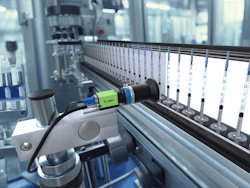How to Optimize Manufacturing with RFID Technology and Enterprise Software
For manufacturers, the efficient handling and management of work- in-process (WIP) goods is critical for maintaining competitiveness and meeting customer demands. While enterprise resource planning (ERP) and manufacturing execution systems (MES) are great for managing parts of this process, these technologies are only as good as the information they receive. This can be a challenge in complex manufacturing operations, including food and beverage, automotive and pharmaceutical.
Despite relying on ERP/MES technologies, these industries still need automated systems in place on the plant floor that can quickly and efficiently capture WIP data—including the status and location of materials as they flow through the system. These operations have similarities with automated warehouses, and many of the strategies for improving efficiency in the warehouse also apply to the manufacturing floor.
A key technology to overcoming these hurdles and enabling real-time visibility into the status of goods is radio frequency identification (RFID) technology. When paired with the right enterprise software, RFID solutions connect every device, asset and worker into a consistent and scalable platform, enabling manufacturers in complex industries to optimize productivity, efficiency and cost.
Automation Offers Many Benefits—But Challenges Remain
ERP/MES technologies can help many manufacturers manage and control inventory, reducing the costs, errors and waste associated with traditional labor-intensive tasks. Some of the functions ERP/MES typically handle include receiving and shipping, picking and placing, inventory tracking, forecasting, scheduling and inventory routing.
While these systems have come a long way since the pen and clipboard, they still rely on humans for tasks, driving labor and incurring hidden costs. Some of these functions include:
- Counting and tracking inventory, using handheld barcode scanners.
- Collecting data on the warehouse floor, such as a part, serial or order number.
- Labeling goods and assigning a unique barcode to each item.
Labor-intensive functions such as these also come with turnover costs, training, absences and injuries—all of which cut into productivity.
Food and beverage, automotive and pharmaceutical manufacturing operations face additional challenges as well. These include:
Inventory management. Like many warehousing operations, maintaining accurate inventory data can be difficult for manufacturers. Inaccurate records can lead to under- or overstocking, disrupting the flow of in-process goods and affecting production and delivery schedules. The effects of efficient (or inefficient) in-process inventory management will ripple across the entire supply chain, impacting other processes like replenishing manufacturing inputs.
Integration with other systems. Effectively integrating manufacturing operations with ERP/MES is important for managing in-process goods. Proper integration ensures all aspects of the supply chain are aligned and that information flows seamlessly between the different systems.
Material handling. Like warehouses, manufacturing operations rely on proper material handling to effectively manage in-process goods and materials. Components must move efficiently from one stage to the next with minimal handling time and a low risk of damage.
RFID Offers Excellent Speed and Accuracy
RFID technology addresses these issues in manufacturing, taking MES/ ERP to the next level. This technology uses electromagnetic fields to identify and track objects that have a unique tag. The tag stores relevant information about the item on a chip and exchanges that information with an RFID reader.
READ MORE: How Zebra Technologies Uses Machine Vision to Transform Production Automation
Though still a valuable way to streamline inventory management, barcode scanners alone won’t do the trick—particularly if you’re looking to optimize for labor and efficiency. RFID readers can scan multiple items for faster, more efficient inventory counting. Because tags are embedded in plastic and can even be inserted into the item, RFID is also less susceptible to the risks that come with scanning wear- and damage-prone labels, providing more accurate counts.
Active vs. Passive RFID Technology
In passive RFID systems, an RFID reader transmits an energy field that “wakes up” the tag and provides power for the tag to respond to the reader. Passive tags don’t include a battery and draw their power from the reader, which is what sends out electromagnetic waves to induce a current in the tag’s antenna. Since the tags obtain their power from the reader, they generally have shorter read ranges. Passive RFID is relatively inexpensive and found in many applications.
Active RFID systems include a battery in the tag that boosts the tag’s operating range and supports additional features like temperature sensing. Data collected from tags is then passed through cabled or wireless communication interfaces to a host computer system in the same way that data scanned from barcode labels is passed to a computer system for interpretation, storage and action.
Active RFID systems can transmit data over longer distances and are usually larger and costlier than their passive counterparts. They will also remain operational so long as the battery is functional. On the other hand, passive RFID—which is the more common of the two—features an optimal combination of benefit and cost and uses a frequency that fits many applications.
Since RFID makes data input and sharing easy, it minimizes manual, labor-intensive processes and eliminates paper documents and their associated errors and inefficiencies. Taken together, RFID is faster, more accurate and requires less labor, all while providing real-time asset tracking and monitoring.
Here’s an overview of RFID devices that can help manufacturers manage the flow of goods and reduce labor requirements on the plant floor:
Handheld RFID readers. These devices give users the flexibility to track and trace goods in real time, and their portability and rugged construction are ideal for a wide range of facilities. Examples of handheld RFID readers include:
- Mobile computers equipped with short-range UHF RFID functionality.
- Wearable Android devices featuring connectivity in a modular, ergonomic package.
- Hybrid units that enable both handheld and hands-free scanning.
- Rugged, efficient RFID sleds. One such sled, Zebra’s RFD40, is capable of more than 1,300 tag reads per second for high-speed cycle counting.
Fixed RFID readers. Fixed RFID readers offer speed and simplicity for managing high volumes of goods. These devices are typically installed at a specific location—such as exit or entry points like a loading dock, doorway or conveyor—where they can scan objects on the move or scan a wide zone at one time.
Thanks to their high bandwidth and computing power, fixed RFID readers can read entire pallets of goods. Their benefits include fewer labor requirements, greater accuracy and time and cost savings. These readers typically come with an integrated antenna plus 10/100Base T Ethernet connectivity, as well as options for Wi-Fi, Bluetooth, 5G, GPS or private cellular communications.
Pairing RFID With the Right Inventory Management Software
To get the most from your manufacturing operation, it’s important to centralize your RFID data using a robust inventory management software platform. The right software doesn’t just help you manage, track and locate goods in real time; it can also eliminate laborious functions like manual cycle counting while delivering speedy audits.
READ MORE: Inside Look: A Design Engineer’s Guided Tour of Zebra Technologies’ R&D Facility
For example, MotionWorks Enterprise Software collects, manages and analyzes real-time data from tagged assets, readers and sensors to create accurate and meaningful information that manufacturers can act on quickly. MotionWorks provides all the resources needed to collect data and report on inventory movement via reports, streams and APIs, plus mapping and monitoring. Features include:
- Centralized sensor management.
- Scalability.
- Simple configuration and setup.
- Consistent visibility.
- Interoperability with third-party applications.
- Continuous support.
Optimize Asset Visibility and Worker Productivity
RFID technology leverages high-speed, high-volume and high-accuracy data capture to provide real-time information as part of an interoperable, holistic ERP/MES. When paired with robust enterprise management software that centralize all inventory data, RFID technology can help manufacturers optimize asset visibility and worker productivity, all while minimizing costs.
More information about RFID technology from Zebra can be found here.


